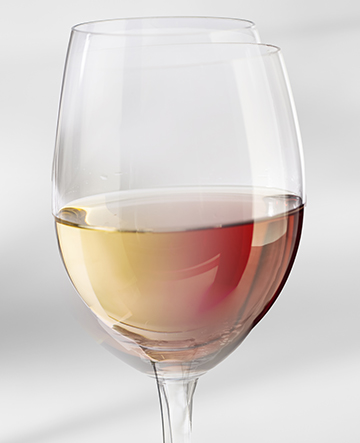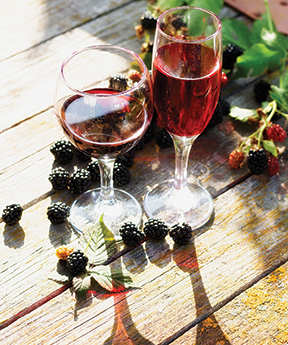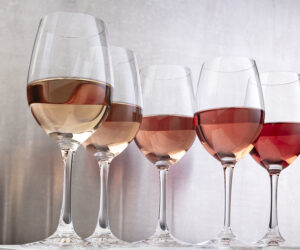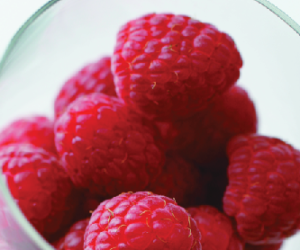
Historically, people have made wine from any ingredients they can find that will ferment. What most likely started as wild foraged fruits, vegetables, herbs, and honey, gradually evolved with civilization to commercially produced agricultural products. These commercially grown fruits have even further evolved in the modern era to pasteurized juices and concentrates that are easily sourced and shipped to any home winemaker to create a consistent and tasty homemade wine. Homebrewing and winemaking have transitioned from an ancient technology to a modern art with the resurgence of interest in DIY and homesteading practices. Sometimes referred to as “country” wines, non-grape fruit-based wines have traditionally been a small-batch, relatively unknown product, staying in the cellars of their home creators or as special projects in commercial wineries located outside of traditional wine regions. In recent years, the popularity and interest in these fruit-based wines has increased and become less of a novelty and more of a well-respected winemaking product.
Perhaps the unique qualities of fruit-based wines have been overlooked and may have not only earned their own spotlight, but also may be a key ingredient in successful grape-based wines as well. Here we will present the possibilities of fruit and grape wine blending, examine the benefits and challenges of the practice, and look at specific case examples of its delicious success.
Grapes have historically been the most popular ingredient in winemaking. Grapes naturally contain a high sugar level and acid content that is conducive to producing a balanced and palate-pleasing product. Unfortunately, any seasoned home winemaker can attest that not all grapes are created equal, and some may be lacking upon fermentation. Some wines, for one reason or another, lack strong fruit flavor and character. Perhaps the fermentation got too hot, perhaps heavy rains prior to picking diluted the grape phenolic content, perhaps a new yeast strain selection didn’t provide the desired character that the winemaker had envisioned. For any of these reasons and a myriad of others, a resulting wine may lack strong flavor or character. This may be an excellent opportunity to look to other fruit-based wines as blending components to improve the overall character and flavor of the grape wine. The possibilities of flavor combinations are endless when considering all of the options available.
A natural course of thinking when blending would be to select a non-grape wine that has the flavor you would like to enhance within the grape wine. An example could be cherry flavors in a Pinot Noir. If a Pinot Noir ferments too hot and fast, some of the fresh cherry flavors common to the variety may not manifest as such, instead coming across as cherry jam, cooked cherries, or not at all. By blending in some cherry wine, a more dominant and fresh cherry character can be achieved. A similar example for white wines could be found in a Riesling. If a Riesling wine has a problematic hot fermentation or the grapes have a tough growing year, the resulting wine could lack some of the expected fruity characters of stone fruits and citrus. By blending in some apricot or peach wine, the vibrancy of fruit flavors can be increased in the Riesling, resulting in a more pleasing, fruit-forward wine for the drinker.
Blending considerations
Sounds easy enough, right? Just take some delicious fruit wine and blend it into a less desirable grape wine and get something delicious. As any winemaker knows, it is never that simple. There are some wine chemistry aspects that should be considered and evaluated before any blending begins. Most notably, consider the sugar and acid makeup of the fruit wine.
When selecting your raw ingredients, be sure to use quality fruit or juice from a reputable vendor. After processing, take careful measurements of the sugar and acid content of the juice or must material. Fruit wines often need a significant amount of chaptalization (added sugar) to achieve an alcohol content that will adequately preserve the wine from spoilage. The acid content of other fruits is also very different from the acid content of grapes. While tartaric acid is the dominant acid in grapes, this is not true for other fruits. Berries and citrus fruits have much higher levels of citric acid and apples and pears have higher levels of malic acid than traditional grape musts. A good starting point for an inexperienced fruit winemaker may be to follow a successful fruit wine recipe from a trusted source such as Jack Keller or WineMaker magazine. There are many fruit winemaking forums online as well as articles on WineMaker’s webpage that will offer important information and tips to making a successful first batch of non-grape wine. Even an experienced grape winemaker should do some thoughtful research into the different chemical composition of the new variety of fruit to be fermented.
It is recommended that the fruit wine is balanced in its flavor before blending it into a grape wine. If the fruit wine is too acidic tasting, this astringency will manifest in the grape wine as well. That said, part of the magic of blending can be finding balance by combining wines that are a bit out of balance that complement each other. This is not the same as blending faulted wine with the hope that it will magically no longer be faulted after blending. Most experienced winemakers will agree that if you blend even a small percentage of a bad wine into a good wine, the bad wine will somehow still manage to dominate the flavor profile of the newly blended wine.
Some fruit wines, such as apple, lack a strong acid content. An addition of acid blend (pre-mixed tartaric, malic, and citric acids) can bring up the acidity of fruit wine and help with its stability, flavor, and preservation. A properly balanced apple wine could give excellent fruit character to a lackluster Chardonnay or Cayuga White. Any adjustments to a wine pre- or post-fermentation should always be carefully evaluated in bench trials to give physical evidence of a positive change in the wine with the desired adjustment. With grape as well as non-grape wines, always keep in mind that blending two stable wines together may result in an unforeseen instability, such as tartaric stability or protein instability.

In my professional winemaking experience I have made and contributed to a few wines that are interesting examples of blending fruit and grape wines. There are two varietals that I have blended in different proportions to create two very different styled wines: Petite Sirah and blackberry wine. Petite Sirah naturally can have strong blackberry flavors after fermentation. I did have a vintage that had a difficult growing year and after a controlled, healthy fermentation, lacked the vibrant fruit character of previous vintages of this wine. After trying numerous fruit enhancing tannins in bench trials, I was still not greatly impressed with the results. Luckily, I had a smaller batch of blackberry wine in the winery that was of excellent varietal character. It was boldly fruity and flavorful, with a reasonable pH of 3.65. In my experience, blackberry and raspberry wines are an excellent choice for a beginner fruit winemaker as they retain their dominant flavors and colors after fermentation. Obtaining these qualities can present a challenge with many other fruit varieties. After a few bench trials to see which percentage of blackberry wine would enhance the fruit character of the Petite Sirah, I found that a 5% addition brought out the fruit character I was looking for. This small addition of the blackberry wine significantly revived the lacking Petite Sirah and created a wonderfully fruity, full-bodied red wine and in some respects saved the vintage.
I found this blend to work favorably in another wine in the portfolio as well. The first batch of blackberry juice that I fermented came out beautifully from a sensory and chemistry standpoint. The acidity numbers were great at 9 g/L and a pH of 3.78 after fermentation. The wine was rich in flavor and color and had a bright acidity to the finish that was very enjoyable due to the high levels of citric acid in blackberries. I decided to make this wine into a fortified style to really embrace the rich blackberry flavor. While I was content with the flavor and color, the mouthfeel was decidedly lacking. I make Petite Sirah every year in abundance, and it was the wine in my winery with the highest natural tannin content and the roundest, most lush mouthfeel. Again, bench trials lead me to a harmonious blend of a 10% Petite Sirah addition to the blackberry wine, which added enough tannin to create the rounder, fuller mouthfeel that I desired in the fortified wine.
When conducting bench trials with fruit wines and red grape wines, the vintner does need to take some cautionary steps to preserve the integrity of the wines they are blending. If a red grape wine has undergone malolactic fermentation and still has live, active bacterial cultures within the wine then it can cause the malolactic fermentation to continue in the fruit-based wine that it is introduced to. This would also be true for a Chardonnay that has undergone malolactic fermentation and is then introduced to a fruit wine. Due to the usually higher levels of malic and citric acid in fruit wines, the malolactic bacteria can dramatically alter the fruit wine, with potentially disastrous results. The metabolization of malic acid into lactic acid in fruit wines could result in a very flabby wine with diminished fruit character. The potential metabolization of citric acid in a fruit wine could lead to a development of volatile acidity or diacetyl, a wine fault that displays unwanted flavors of butter or buttered popcorn. A simple way to stabilize the wines and help to eliminate an accidental bacterial fermentation of the fruit wine acid would be to utilize a product such as Stab Micro by Enartis. The product will kill both gram-negative and gram-positive bacteria found in the wine and when used in conjunction with proper sulfite levels and additions, can provide the winemaker with a stable blending product.
Blending at Taylor Brooke Farm Winery
Aside from my own experience blending fruit and grape wines, I was fortunate to have the opportunity to speak with Nikki Auger, Owner and Winemaker of Taylor Brooke Farm Winery in Woodstock, Connecticut. Taylor Brooke Winery was founded in 2004 by Dick and Linda Auger. Nikki joined the family business in 2016, learning the family recipes and winemaking practices from her father. She carries on his talents and legacy today managing 7.5 acres where seven grape varieties are grown. As the Field Manager and Head Vintner, she is very busy creating a large and diverse portfolio of vinifera, hybrid, and fruit wines. In recent years, she has launched some very successful new wines in the portfolio that are blends of grape and fruit wines, or co-ferments of grapes with other fruits.
Petite Veraison is a sparkling apple cider that is fermented on red wine grape skins. In two various vintages, Nikki has used both vinifera (Petite Sirah) and hybrid (Corot Noir) grape skins in the fermentation of locally grown and pressed apple cider. Auger sources a specialty blend of more dessert style apples to get a pressed cider with a higher pH value than typical cider blends. She prefers a less tart cider in anticipation that it will blend with hybrid grapes of stronger acidity levels. For the 2021 vintage, Corot Noir skins were reserved after pressing, vacuum-sealed in bags, and kept under very cold refrigeration until it was time to ferment the cider. The primary fermentation of the Corot Noir did utilize a separate strain of Saccharomyces and malolactic cultures. Auger has had success with the refrigeration technique to arrest any fermentation or oxidation of the skins until they are ready for their next use.
When the apple juice is ready, the skins are placed at the bottom of a large macro bin and the apple juice is poured on top and the yeast set. She creates a very strong healthy yeast starter culture and utilizes a yeast nutrition program to ensure the yeast she has selected for the cider fermentation dominates over any remaining Saccharomyces cells within the Corot Noir pomace.
After fermenting to dryness, Nikki presses off the cider and stabilizes quickly with sulfites and Stab Micro to stave off any malolactic activity. Coarse filtration soon follows to further lend stability to the young cider. At this stage, the cider is deep ruby in color with luscious apple flavor but lacking in body and acidity. Auger blends in a small amount of Corot Noir rosé, made from the same vintage, bled off via the saignée method during the primary fermentation. The rosé lends additional mouthfeel and subtle tannin to the cider blend as well as the acid necessary to create a balanced product. After aging and clarification filtering, the resulting product is force carbonated and bottled for sale at their winery and brewery.
The 2020 vintage of this cider was fermented on Petite Sirah skins, giving it a deeper magenta hue than the Corot Noir vintage, which retained more of a ruby tone. It greets the drinker with luscious berry and apple flavors and has excellent bubble retention. While the wine is boldly fruity with refreshing apple character, it does have the drying character and tannic mouthfeel from the contribution of Petite Sirah skins. The acids and tannins give it excellent palate clearing attributes and a refreshing quality.
Not all blending projects go as smoothly, and Auger was candid about some of the more challenging fruit and grape blending that she has accomplished. One of the most popular wines in her portfolio is a Cranberry Riesling. The wine is a gorgeous bright ruby with overt, bold cranberry character. To achieve this blend, Auger starts with fresh Riesling juice from Lodi, California. She prefers this growing region for her Riesling as it generates a lower acidity wine upon fermentation. She prefers the higher pH to that of an East Coast Riesling, which due to a cooler growing climate may have significantly higher levels of acid.
She ferments fresh cranberries separately as well. The crushing and pressing process is significantly more laborious than grapes due to the hard flesh of the cranberries. The fresh pressed cranberry juice can have pH levels as low as 2.6 with acidity counts as high as 77 g/L. Nikki will lower the acidity as much as possible using potassium bicarbonate to get a fermentable pH ideally above 2.9. The primary acid within cranberries is citric acid, so the acidity is challenging to adjust as the bicarbonate reacts with the tartaric acid components of the cranberry juice. She relies on pH more than the total acidity counts for the cranberry wine to account for the varying acids. The fermentation is typically long and slow due to the high acidity. In her experience, fermenting the cranberry juice to dryness results in a wine that lacks cranberry flavor and is more tart than anything else. By stopping the fermentation early with approximately 5 °Brix remaining, she can retain more of the cranberry flavor and character that she desires in the resulting blend.
Once the cranberry and Riesling wines are stabilized and clarified independently, they will then be blended in a proprietary ratio, along with a small amount of Corot Noir rosé, to create the Cranberry Riesling.
With a core base of tried-and-true family recipes and new, avant-garde methods and techniques, Nikki is redefining East Coast winemaking. Utilizing a wide array of grapes, both homegrown hybrids as well as purchased vinifera grapes from other regions, and now various fruits, she uses every quality ingredient available to her to create complex and unique wines. Both the Petite Veraison and the Cranberry Riesling sell very well on premise. When discussing modern trends in the consumption and craft of wine beverages, Auger thinks that the younger generations are having more of an impact on sales. Younger drinkers enjoy new ideas and combinations and are less concerned with historical winemaking standards and profiles. With the rise of popularity of ciders and flavored seltzers, it is not surprising that the bold fruit flavors of the Petite Veraison finds a niche with younger drinkers.
“That’s how we are making wine on the East Coast, thinking outside of the box and outside the historical standard,” states Auger. “With climate change, we may have to adapt and change our winemaking practices and ingredients.”
This statement rings true for many winemakers who chose to grow grapes in non-traditional growing regions. Weather patterns continue to shift every year, and over time, certain grape crops might not perform as they once had. Exploring other fruit crops for winemaking may make more environmental and economic sense as time marches on.
Many varieties of fruits have been utilized since the dawn of winemaking to create tasty beverages. While grapes rose to prominence in winemaking — regarded for their chemistry to make the “benchmark” wines we have all embraced — as tradition, modern curiosity, climate change, and ingenuity have led to a revaluation of other fruit wines and their place in winemaking. When used in blend post maturation or in the primary fermentation, we can see the myriad of possibilities and combinations that can develop a whole new style of wines. And there may be no better place for this continued experimentation than on the home winemaking scale!
Related Link:
• Blending two wines to create a new wine better than its parts is the goal, but it isn’t something to do on a whim. Learn how to conduct bench trials to get your blends right every time: https://winemakermag.com/technique/performing-bench-trials






